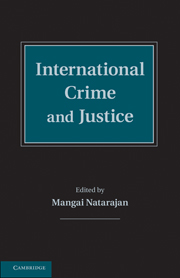Book contents
- Frontmatter
- Contents
- List of Figures
- List of Tables
- List of Contributors
- Foreword
- Preface
- Introduction
- Part I International Criminology
- 1 The Globalization of Crime
- 2 Routine Activities and Transnational Crime
- 3 Migration and Crime
- 4 Political Violence
- 5 Victimology
- 6 Children and International Criminal Justice
- 7 Women and International Criminal Justice
- 8 Culture and Crime
- Part II Law, Punishment, and Crime Control Philosophies of the World
- Part III Transnational Crime
- Part IV Organized Crime and Terrorism
- Part V International crime
- Part VI Delivering International Justice
- Part VII International Cooperation and Criminal Justice
- Part VIII International Research and Crime Statistics
- Part IX International research resources
- World Map
- Index
- References
3 - Migration and Crime
Published online by Cambridge University Press: 05 October 2014
- Frontmatter
- Contents
- List of Figures
- List of Tables
- List of Contributors
- Foreword
- Preface
- Introduction
- Part I International Criminology
- 1 The Globalization of Crime
- 2 Routine Activities and Transnational Crime
- 3 Migration and Crime
- 4 Political Violence
- 5 Victimology
- 6 Children and International Criminal Justice
- 7 Women and International Criminal Justice
- 8 Culture and Crime
- Part II Law, Punishment, and Crime Control Philosophies of the World
- Part III Transnational Crime
- Part IV Organized Crime and Terrorism
- Part V International crime
- Part VI Delivering International Justice
- Part VII International Cooperation and Criminal Justice
- Part VIII International Research and Crime Statistics
- Part IX International research resources
- World Map
- Index
- References
Summary
The relationship between migration and crime is a controversial issue that has received considerable attention from academics, media pundits, and politicians. This chapter discusses the extant literature and summarizes its major research findings. It must be noted though that some matters – in particular measurement related issues – remain unresolved. Researchers must determine, for instance, if they wish to study legal migrants, illegal immigrants, or both. The term “migrant” may be operationalized by researchers and nations as foreign-born (counting naturalized citizens as migrants) or noncitizens (counting native born noncitizens as migrants). These differences may make it difficult to compare studies and arrive at general conclusions, since different measurement decisions could lead to contradictory results.
In this chapter we examine current understandings as to whether migration leads to increases in criminal offending, victimization, or both. Under this conception, migration is the independent variable – the cause and crime is the dependent variable – the effect. We would be remiss, if we did not note that the reverse occurs, unfortunately, all too often. Numerous persons migrate to host countries to flee harsh living conditions, war crimes, and other human rights violations occurring in their country of origin. In other instances, criminal syndicates deceive or kidnap vulnerable individuals and transfer them to the host country to work in servitude or to be sexually abused (Aronowitz, 2009). In these cases, crime is the independent variable – the cause, and migration is the dependent variable – the effect.
- Type
- Chapter
- Information
- International Crime and Justice , pp. 19 - 25Publisher: Cambridge University PressPrint publication year: 2010

